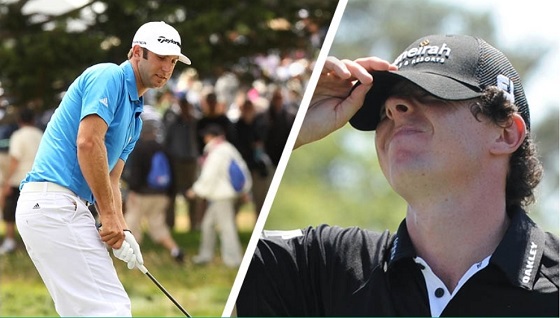Equipment
In the Bag: Scheffler’s Winning strategy at the WM Open

Scottie Scheffler looked like a guy lucky just to be playing the weekend after opening rounds of 68-71, but a third-round 62 put him in contention at the WM Phoenix Open. The 25-year-old then finished the job with four birdies in his last six holes on Sunday at TPC Scottsdale, and one more on the third playoff hole to beat Patrick Cantlay.
A non-descript three-birdie/three-bogey front nine had Scheffler on the periphery for most of the day as Cantlay and Sahith Theegala shared the lead for much of the back nine. Scheffler, however, rolled in a 22-footer for birdie at the 10th before giving that stroke back at the 12th. From there, he took advantage of the course’s risk-reward holes coming in.
A two-putt birdie at the par-5 13th was followed by an approach to 10 feet for another birdie at the 14th. Up-and-down birdies at the par-5 15th and short par-4 17th pulled him into a share of the lead. At the last, a lob wedge from 100 yards to five feet—the closest approach on that hole for the day—left him one last birdie putt for his first PGA Tour win but he couldn’t get it to go.
Still, Scheffler shook it off and came through in extra holes, fittingly making one more birdie for the victory. The former University of Texas All-American led the field in birdies with 27, aided by a strong game off the tee. Scheffler uses TaylorMade’s new Stealth Plus driver (with 8 degrees of loft) and ranked sixth in strokes gained/off-the-tee, picking up almost five shots on the field while also averaging 327.9 yards off the tee.
The other end of the bag was strong as well, with Scheffler ranking second in strokes gained/putting, gaining more than seven shots and second in putts per green in regulation with his Scotty Cameron by Titleist prototype putter.
A putter that had one more birdie in it—a 26-footer—for the win.
What Scottie Scheffler had in the bag at the WM Phoenix Open
Ball: Titleist Pro V1
Driver: TaylorMade Stealth Plus (Fujikura Ventus Blue 7X), 8 degrees
3-wood: Nike VR Pro LTD, 15 degrees
Irons (3-4): Srixon ZU85; (5-PW): TaylorMade P7MC
Wedges: Titleist Vokey SM8 (50, 56 degrees); Titleist Vokey WedgeWorks prototype (60 degrees)
Putter: Scotty Cameron by Titleist prototype
This article originally appeared on Golf Digest.
Blog
Why Proper Club Fitting Is the Real Game Changer

If you’ve ever walked off the 18th green thinking, “It’s not me, it’s the clubs,” well… you might be half right.
As a PGA Professional who’s watched thousands of swings—from scratch players to first-timers—I can tell you that one of the most overlooked keys to better golf is proper club fitting. Not just buying shiny new sticks off the rack, but taking the time to find clubs that are tailored to your swing.
You don’t need a Tour card to get Tour-level precision. Let’s talk about why club fitting matters, what it changes, and how it can truly transform your game from the tee box to the final putt.
The Myth of “Good Enough”
“I’m not good enough to be fit for clubs.”
That’s the most common thing I hear—and it’s completely backwards.
High-handicap golfers have even more to gain from club fitting than low-handicappers. Why? Because the equipment can help you fix ball flight, optimize distance, reduce mis-hits, and build confidence—all without having to reinvent your swing.
Off-the-rack clubs are designed to fit “average” specs. But no two golfers are the same. Length, lie angle, shaft flex, grip size—these all play a massive role in how the club interacts with your body and the ground.
What Happens in a Proper Club Fitting?
At its core, a fitting session is about matching the equipment to your natural swing—not forcing you to swing a certain way to fit the gear.
Here’s what a proper club fitting includes:
1. Interview & Swing Assessment
A certified fitter (or PGA pro like myself) will ask about your current set, ball flight tendencies, common misses, and goals. Then we’ll watch you hit some shots to get a baseline.
2. Launch Monitor Data
Using tools like TrackMan or Foresight, we’ll capture numbers like:
- Ball speed
- Launch angle
- Spin rate
- Club path and face angle
- Carry distance and dispersion
These numbers don’t lie—and they tell us what to tweak.
3. Testing Head & Shaft Combinations
You’ll hit several combinations of club heads and shafts to find what gives you the best performance. One degree of loft or a different shaft flex can make a huge difference.
4. Dialing In Lie Angle & Length
Lie angle affects directional control—too upright, and you might pull shots left; too flat, and you’ll miss right. Club length affects control, consistency, and strike location.
5. Grip Size & Feel
Don’t underestimate this. A grip that’s too thick or too thin can alter your grip pressure and release pattern.
Real Results—Backed by Data
One of my students recently went through a full iron fitting. He was using clubs he bought off the rack 10 years ago. His miss was a push-fade, and he struggled with distance control.
After 90 minutes, a combination of slightly shorter shafts, softer flex, and two degrees more upright lie changed everything. His dispersion tightened by 40%, and he gained an average of 12 yards per club. More importantly—his confidence skyrocketed.
And it wasn’t just him. Across the board, golfers who get fitted:
- Gain more consistent contact
- Reduce directional misses
- Improve distance gapping
- Hit more greens in regulation
- Score better, without changing their swing
The Mental Game Boost
Here’s a secret: it’s not just about numbers. Fitted clubs give you confidence. When you know the tool in your hand is built for you, you swing freer, commit more fully, and stop second-guessing every shot.
Confidence leads to better swings. Better swings lead to better results. It’s a cycle—and it starts with the right equipment.
What About Cost?
Yes, a proper fitting might cost $75–$150 depending on where you go. And yes, custom-fit clubs may be slightly more than what you’d pay at a big box store.
But if you’re already spending time and money on golf, wouldn’t you want to get the most out of it?
A one-time investment in fitting can save you years of frustration—and possibly hundreds spent chasing fixes that won’t work with ill-fitting clubs.
Look—I’ve given thousands of lessons in my career, and nothing changes a golfer’s outlook faster than finally swinging clubs that work with them, not against them.
Whether you’re a 5 handicap trying to fine-tune yardages or a 25 handicap tired of slicing your driver, a proper club fitting can absolutely be a game changer.
You don’t need a new swing—you just need the right tools.
So before you spend another dollar on swing gadgets or tip videos, find your local PGA professional or certified fitter and book a session. Your game (and your sanity) will thank you.
Want more ways to play better without starting over?
Visit ClickItGolf.com every week for practical golf improvement tips, equipment reviews, betting insights, and advice from golfers who live the game every day.

Golf attire has undergone significant transformations over the centuries, evolving from formal, restrictive clothing to today’s stylish, performance-oriented apparel.

Before 1920
Originating in the cold, windy landscapes of Scotland, early golfers dressed primarily for warmth and protection. Typical attire included full tweed suits, often accompanied by waistcoats and neckties. Knickers, resembling knee breeches, were common, paired with high socks and sturdy leather shoes. Hats varied from pork-pie styles to wide-brimmed designs. While functional against harsh weather, this layered clothing restricted movement, impacting players’ swings.

1920s – 1960s
As golf gained popularity in the United States, attire began to reflect contemporary fashion trends. The 1920s introduced plus-fours—knickers extending four inches below the knee—paired with two-toned shirts and, occasionally, ties. In cooler conditions, players opted for knitted wool cardigans or Norfolk jackets. The 1930s saw a shift to lighter fabrics, with short-sleeved knitted shirts and slacks becoming common. Outerwear like the Eisenhower jacket and cardigan sweaters with bell-shaped sleeves allowed greater freedom of movement. Footwear evolved to feature sturdy leather shoes with spikes, enhancing grip on the course.

1960s – 2000
The 1960s marked a departure from muted tones, embracing vibrant colors such as greens, blues, and reds. Bold tops contrasted with lighter trousers or shorts, reflecting the era’s fashion sensibilities. Public figures like President John F. Kennedy popularized “Go to Hell” pants—colorful, shorter trousers in eye-catching hues. Recognizing the growing market, brands like FootJoy, Adidas, Nike, Polo Golf Ralph Lauren, and Ashworth launched dedicated golf apparel lines. However, endorsements by celebrity players remained understated during this period.

Since 2000
By the late 1990s, golf had cemented its status among top U.S. sports, leading to lucrative endorsements and a surge in golf club memberships. The game’s evolving dynamics emphasized athleticism, precision, and speed, necessitating advancements in attire. Lightweight, comfortable, and elegant clothing became the norm. Colorful, collared cotton T-shirts paired with tan or khaki shorts or trousers dominated the fairways. Headwear transitioned to pork-pie shapes and baseball caps, while footwear saw a shift from traditional leather to sporty designs from brands like Nike and Adidas.

After 2010
The past decade has witnessed a significant shift in golf fashion, influenced by broader cultural trends and technological advancements. The rise of athleisure blurred the lines between sportswear and casual wear, leading to the incorporation of jogger-style pants, hoodies, and stretchy, moisture-wicking materials in golf attire. Brands like Lululemon and Under Armour introduced high-performance golf wear suitable both on and off the course. Collaborations with streetwear labels injected a youthful energy into the sport, attracting a new generation of players. Additionally, sustainability became a focal point, with companies like Reflo producing apparel from recycled materials, reflecting a growing environmental consciousness among consumers. citeturn0search26

This evolution of golf attire mirrors the sport’s journey from its traditional roots to a modern, inclusive game that embraces both style and functionality.
Equipment
Mizuno OMOI Putter Review
New putter alert! Mizuno’s OMOI line dropped, and we got our hands on one. These bad boys are all about weight—heavier heads (think 370g+) for a smoother, pendulum-like stroke. The forged steel feels buttery, and the face milling grips the ball just right for a true roll. We tested the Type 1 on a fast green; lag putts were a breeze, and the stability cut down those annoying wobbles. Priced around $300, it’s not cheap, but if your putting’s been a dumpster fire, this might be the fix. Full review coming—stay tuned!
Mizuno M.Craft OMOI Right Handed Putter
- Forged construction for soft feel
- 1025 Mild Carbon Steel: Soft mild carbon steel for an incredibly soft feel
- Precision CNC Milled: Precisely milled shape and deep milled face for a softer feel and pure roll
- Custom Fit Weight Kit: Includes two 3 gram weights, two 13 gram weights to be interchanged with the two 8 gram fitted weights allowing the M CRAFT to adjust to a variety of desired weightings
-

 Product Review6 years ago
Product Review6 years agoThe Perfect Practice Putting Mat Review by Jason Tenzer
-

 Blog4 years ago
Blog4 years agoLoophole Rule Offers PGA Tour Pros a Mulligan
-

 Blog4 years ago
Blog4 years ago2021 Buyer’s Guide: The Top 10 Value Golf Balls For Distance & Feel
-

 Blog4 years ago
Blog4 years agoGolf Marriage Counselor
-

 Blog6 years ago
Blog6 years ago9 Biggest Chokes Of The Past Decade
-

 Product Review6 years ago
Product Review6 years agoTHE ADJUSTABLE IRONS: WALKING STICKS GOLF CLUBS
-

 Blog4 years ago
Blog4 years agoWhat Your Golf Clubs Say About You
-

 Equipment6 years ago
Equipment6 years agoOHK Sports Interview by Jason Tenzer






























